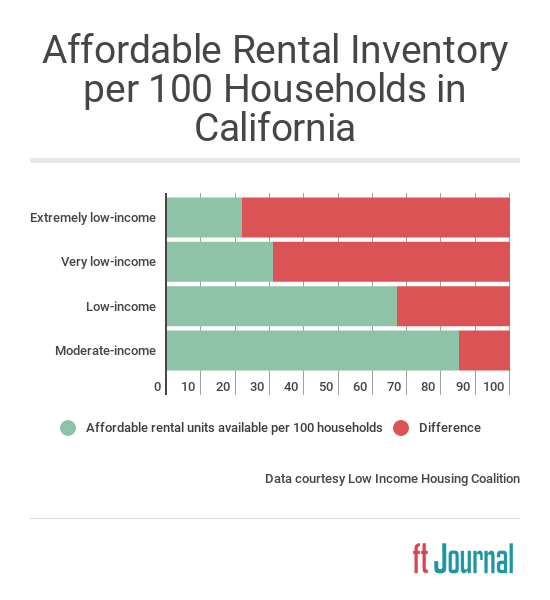California lacks sufficient housing to shelter its rental population, according to the National Low Income Housing Coalition. In fact, the Golden State is one of the worst states in the U.S. when it comes to affordable rental housing for its low-income residents, only behind Nevada and Florida.
Financial experts recommend limiting housing costs to 31% of a household’s monthly income. But due to a lack of available housing, this is simply impossible for many households.
In California, the share of renters spending more than 30% of their monthly income on rent as of 2016 is:
- 90% of extremely low-income households;
- 85% of very low-income households;
- 64% of low-income households; and
- 39% of moderate-income households.
Worse, the percentage of renters spending more than 50% of their monthly income on rent in California is:
- 77% of extremely low-income households;
- 48% of very low-income households;
- 18% of low-income households; and
- 5% of moderate-income households.

For extremely and very low-income households, these figures translate to over 1.5 million affordable units that are missing from the rental inventory.
High renter burden = fewer homebuyers
Real estate agents and brokers — this isn’t just a problem for renters. When low- and moderate-income renters are unable to find affordable housing, they spend a larger portion of their paycheck on shelter, leaving very little leftover for saving up for down payments, necessary if they are to become homebuyers.
The problem also extends to low- and mid-tier homes for sale. There aren’t enough low- and mid-tier homes in the inventory to meet homebuyer demand. Six of the nation’s top ten least affordable homebuying markets are in California, according to Zillow.
In order for California’s housing market to meet the needs of all its residents, more housing will need to be added to the for-sale inventory and the rental inventory. This process is already underway, as several new housing laws aimed at more construction of low- and mid-tier housing passed at the end of 2017.
Look to the end of 2018 and into 2019 for the effects of the new legislation to result in more residential construction, which will add to the inventory and work to cool down rents and home prices. When prices fall back in line with buyer and renter incomes, California will see more qualified homebuyers, and higher sales volume.














